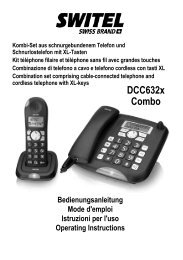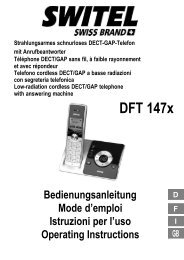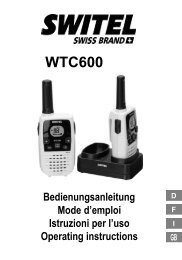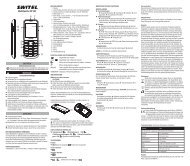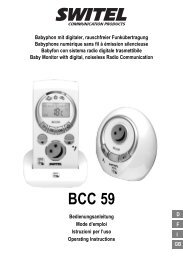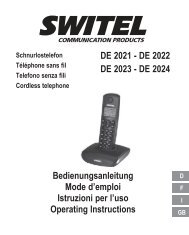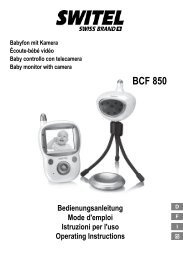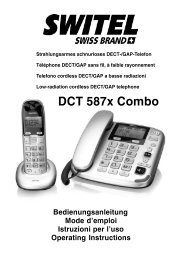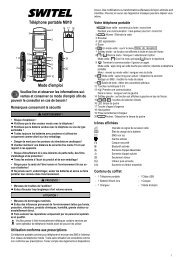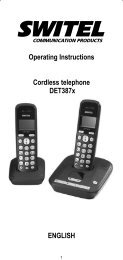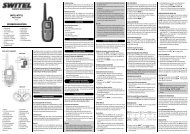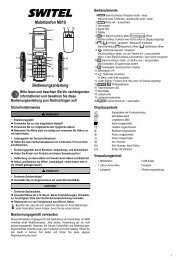DET 3371 DET 3372 DET 3373 DET 3374 - Switel.com
DET 3371 DET 3372 DET 3373 DET 3374 - Switel.com
DET 3371 DET 3372 DET 3373 DET 3374 - Switel.com
Create successful ePaper yourself
Turn your PDF publications into a flip-book with our unique Google optimized e-Paper software.
1 Safety Information<br />
Please read this operating instruction manual thoroughly.<br />
Intended use<br />
The telephone is suitable for telephoning within a public telephone network<br />
system. Any other use is considered unintended use. Unauthorised modification<br />
or reconstruction is not permitted. Under no circumstances open the<br />
device or <strong>com</strong>plete any repair work yourself.<br />
Installation location<br />
Prevent excessive exposure to smoke, dust, vibration, chemicals, moisture,<br />
heat and direct sunlight.<br />
Do not use the handset in potentially explosive areas.<br />
Power adapter plug<br />
a Attention: Only use the power adapter plug supplied because other<br />
power supplies could damage the telephone. Ensure access to the power<br />
adapter plug is not obstructed by furniture or such.<br />
Rechargeable batteries<br />
a Attention: Never throw batteries into a fire. Only use batteries of the<br />
same type. Pay attention to the correct polarity. Incorrect polarity of the<br />
batteries represents a risk of explosion during charging.<br />
Power failure<br />
The telephone cannot be used to make calls in the event of a power failure.<br />
Always keep a cord connected telephone which operates without an external<br />
power supply available in case of emergency situations.<br />
Low-radiation operation (ECO mode)<br />
In talk mode, radiation is reduced (depending on the distance between the<br />
handset and base station).<br />
Low-radiation operation by MAXI ECOmode<br />
In “MAXI ECOmode“, the radiation (DECT transmission power) of both<br />
base station and handset is turned off in stand-by. This will also work if multiple<br />
handsets are connected, given that they all support “MAXI ECOmode“.<br />
Medical equipment<br />
a Attention: Never use the telephone in the vicinity of medical equipment.<br />
Effects on such equipment cannot be fully ruled out.<br />
DECT telephones can cause an unpleasant humming sound in hearing<br />
aids. DECT: Digital Enhanced Cordless Tele<strong>com</strong>munication = Standard for<br />
cordless telephones.<br />
Disposal<br />
In order to dispose of your device, take it to a collection<br />
point provided by your local public waste authorities (e.g.<br />
recycling centre). The adjacent symbol indicates that the<br />
device must not be disposed of in normal domestic waste!<br />
According to laws on the disposal of electronic and electrical<br />
devices, owners are obliged to dispose of old electronic<br />
and electrical devices in a separate waste container.<br />
Batteries must be disposed of at the point of sale or at the<br />
appropriate collection points provided by the public waste<br />
authorities.<br />
Packaging materials must be disposed of according to<br />
local regulations.<br />
2 Preparing the Telephone<br />
Safety information<br />
a Attention: It is essential to read the Safety Information in Chapter 1<br />
before starting up.<br />
Connecting the base station<br />
a Attention: Position the base station at least 1 m away from other<br />
electronic devices, otherwise there is a risk of mutual disturbance.<br />
Connect the base station as illustrated in the diagram. For reasons of<br />
safety, only use the power adapter plug and telephone connection line<br />
supplied.<br />
Telephone line socket<br />
Mains power outlet<br />
a Attention: Use only the power adapter plug supplied with the base<br />
station!<br />
1<br />
GB



